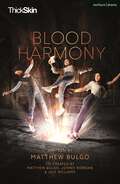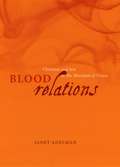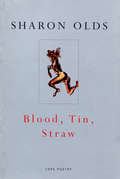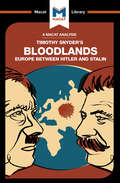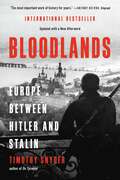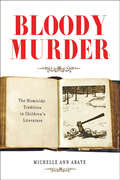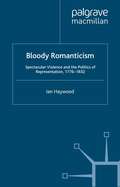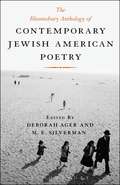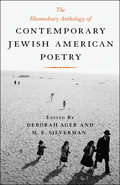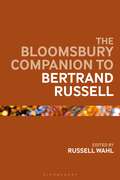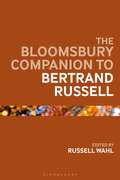- Table View
- List View
Blood Brothers GCSE Student Edition (GCSE Student Guides)
by Willy Russell Ros MerkinWritten specifically for GCSE students by academics in the field, the Methuen Drama GCSE Student Editions provide in-depth explanatory material alongside the play texts frequently studied at Key Stage 4. Whether for use in the classroom or independent study, these editions offer a fully comprehensive and lightly glossed play text with accompanying notes specifically directed towards readers of this age, which unravel essential topics and challenge all students to delve further into literary analysis. A well established modern classic, Willy Russell's Blood Brothers tells the story of Mickey and Eddie, twins separated at birth who grow up to lead very opposite lives, but which constantly and inevitably intersect. In addition to some on-page explanatory notes and the play text, this edition contains sub-headed analyses of themes, characters, context and dramatic devices, as well as background information on the playwright. The Methuen Drama GCSE Student Editions never lose sight of their readership, and offer students the confidence to engage with the material, explore their own interpretations, and improve their understanding of the works.
Blood Brothers GCSE Student Guide (GCSE Student Guides)
by Ros MerkinWritten specifically for GCSE students by academics in the field, the Methuen Drama GCSE Guides conveniently gather indispensable resources and tips for successful understanding and writing all in one place, preparing students to approach their exams with confidence.Key features include a critical commentary of the play with extensive, clearly labelled analyses on themes, characters and context. They take studying drama even further with sections on dramatic technique, critical reception, related works, fascinating behind-the-scenes interviews with playwrights, directors or actors, and a helpful glossary of dramatic terms.A well-established modern classic, Willy Russell's Blood Brothers tells the story of Mickey and Eddie, twins separated at birth who grow up to lead very opposite lives, but which constantly and inevitably intersect.Closely following the requirements of GCSE English Literature assessment objectives, these studies include expert advice on how to write about modern drama. With featured activities for group study and independent work, they are versatile and valuable to students and teachers alike.
Blood Brothers GCSE Student Guide (GCSE Student Guides)
by Ros MerkinWritten specifically for GCSE students by academics in the field, the Methuen Drama GCSE Guides conveniently gather indispensable resources and tips for successful understanding and writing all in one place, preparing students to approach their exams with confidence.Key features include a critical commentary of the play with extensive, clearly labelled analyses on themes, characters and context. They take studying drama even further with sections on dramatic technique, critical reception, related works, fascinating behind-the-scenes interviews with playwrights, directors or actors, and a helpful glossary of dramatic terms.A well-established modern classic, Willy Russell's Blood Brothers tells the story of Mickey and Eddie, twins separated at birth who grow up to lead very opposite lives, but which constantly and inevitably intersect.Closely following the requirements of GCSE English Literature assessment objectives, these studies include expert advice on how to write about modern drama. With featured activities for group study and independent work, they are versatile and valuable to students and teachers alike.
Blood Harmony (Modern Plays)
by Matthew BulgoShe used to be everywhere, all at the sametime, do you know what I mean?And now she's nowhere.She was always there,that's what I'm trying to say.A fractured trio of sisters are pulled back together with news that turns their worlds upside down. Tensions from the past and worries about the future leave them feeling paralysed. When it feels like your world has come to a stop, how do you find a way to keep moving forward?Soaring music by Atlantic Records artists, The Staves, combines with dynamic movement and bold new writing in this compelling, intimate reflection on grief and the invisible bonds within families. Blood Harmony is a play with songs that'll make you want to pull your family a little closer and hold them a little tighter.
Blood Harmony (Modern Plays)
by Matthew BulgoShe used to be everywhere, all at the sametime, do you know what I mean?And now she's nowhere.She was always there,that's what I'm trying to say.A fractured trio of sisters are pulled back together with news that turns their worlds upside down. Tensions from the past and worries about the future leave them feeling paralysed. When it feels like your world has come to a stop, how do you find a way to keep moving forward?Soaring music by Atlantic Records artists, The Staves, combines with dynamic movement and bold new writing in this compelling, intimate reflection on grief and the invisible bonds within families. Blood Harmony is a play with songs that'll make you want to pull your family a little closer and hold them a little tighter.
Blood Relations: Christian and Jew in The Merchant of Venice
by Janet AdelmanIn Blood Relations, Janet Adelman confronts her resistance to The Merchant of Venice as both a critic and a Jew. With her distinctive psychological acumen, she argues that Shakespeare’s play frames the uneasy relationship between Christian and Jew specifically in familial terms in order to recapitulate the vexed familial relationship between Christianity and Judaism. Adelman locates the promise—or threat—of Jewish conversion as a particular site of tension in the play. Drawing on a variety of cultural materials, she demonstrates that, despite the triumph of its Christians, The Merchant of Venice reflects Christian anxiety and guilt about its simultaneous dependence on and disavowal of Judaism. In this startling psycho-theological analysis, both the insistence that Shylock’s daughter Jessica remain racially bound to her father after her conversion and the depiction of Shylock as a bloody-minded monster are understood as antidotes to Christian uneasiness about a Judaism it can neither own nor disown. In taking seriously the religious discourse of The Merchant of Venice, Adelman offers in Blood Relations an indispensable book on the play and on the fascinating question of Jews and Judaism in Renaissance England and beyond.
Blood Relations: Christian and Jew in The Merchant of Venice
by Janet AdelmanIn Blood Relations, Janet Adelman confronts her resistance to The Merchant of Venice as both a critic and a Jew. With her distinctive psychological acumen, she argues that Shakespeare’s play frames the uneasy relationship between Christian and Jew specifically in familial terms in order to recapitulate the vexed familial relationship between Christianity and Judaism. Adelman locates the promise—or threat—of Jewish conversion as a particular site of tension in the play. Drawing on a variety of cultural materials, she demonstrates that, despite the triumph of its Christians, The Merchant of Venice reflects Christian anxiety and guilt about its simultaneous dependence on and disavowal of Judaism. In this startling psycho-theological analysis, both the insistence that Shylock’s daughter Jessica remain racially bound to her father after her conversion and the depiction of Shylock as a bloody-minded monster are understood as antidotes to Christian uneasiness about a Judaism it can neither own nor disown. In taking seriously the religious discourse of The Merchant of Venice, Adelman offers in Blood Relations an indispensable book on the play and on the fascinating question of Jews and Judaism in Renaissance England and beyond.
Blood, Tin, Straw: Poems
by Sharon OldsSharon Olds divides this new book into five sections - 'Blood', 'Tin', ' 'Straw', ' 'Fire' and 'Light' - each made up of fourteen poems whose dominant imagery is drawn from one of these elements. The poems are rooted in different moments of an ordinary life and weave back and forth in time. Each section suggests the progression of the making of a soul cleansed by blood, forged by fire, suffused by light. Unafraid to confront the ecstatic or the brutal side of a woman's experience, Sharon Olds transforms the subjects with an alchemist's art, using language that is alternately casual and startling, fierce and transcendent. This is an intensely moving collection by one of America's finest poets.
Bloodlands: Europe Between Hitler and Stalin (The Macat Library)
by Helen RocheA flagbearer for the increasingly fashionable genre of "transnational history," Timothy Snyder's Bloodlands is, first and foremost, a stunning example of the critical thinking skill of evaluation. Snyder's linguistic precocity allows him to cite evidence in 10 languages, putting fresh twists on the familiar story of World War II fighting on the Eastern Front from 1941-45. In doing so, he works to humanize the estimated 14 million people who lost their lives as their lands were fought over repeatedly by the Nazis and their Soviet opponents. Snyder also works to link more closely the atrocities committed by Hitler and Stalin, which he insists are far too often viewed in isolation. He focuses heavily on the adequacy and relevance of his evidence, but he also uses the materials he has culled from so many different archives as fuel for an exemplary work of reasoning, forcing readers to confront the grim realities that lie behind terms such as ‘cannibalism’ and ‘liquidation.’ In consequence, Bloodlands has emerged, only a few years after its publication, as one of the seminal works of its era, one that is key to Holocaust studies, genocide studies and area studies, and to sociology as well as to history. A masterly work of literature as well as of history, Bloodlands will continue to be read for decades.
Bloodlands: Europe Between Hitler and Stalin
by Timothy SnyderFrom the bestselling author of On Tyranny, the definitive history of Hitler's and Stalin's wars against the civilians of Europe in World War TwoAmericans call the Second World War "The Good War."But before it even began, America's wartime ally Josef Stalin had killed millions of his own citizens--and kept killing them during and after the war. Before Hitler was finally defeated, he had murdered six million Jews and nearly as many other Europeans. At war's end, both the German and the Soviet killing sites fell behind the iron curtain, leaving the history of mass killing in darkness. Bloodlands is a new kind of European history, presenting the mass murders committed by the Nazi and Stalinist regimes as two aspects of a single history, in the time and place where they occurred: between Germany and Russia, when Hitler and Stalin both held power. Assiduously researched, deeply humane, and utterly definitive, Bloodlands will be required reading for anyone seeking to understand the central tragedy of modern history. Bloodlands won twelve awards including the Emerson Prize in the Humanities, a Literature Award from the American Academy of Arts and Letters, the Leipzig Award for European Understanding, and the Hannah Arendt Prize in Political Thought. It has been translated into more than thirty languages, was named to twelve book-of-the-year lists, and was a bestseller in six countries.
Bloodtaking and Peacemaking: Feud, Law, and Society in Saga Iceland
by William Ian MillerDubbed by the New York Times as "one of the most sought-after legal academics in the county," William Ian Miller presents the arcane worlds of the Old Norse studies in a way sure to attract the interest of a wide range of readers. Bloodtaking and Peacemaking delves beneath the chaos and brutality of the Norse world to discover a complex interplay of ordering and disordering impulses. Miller's unique and engaging readings of ancient Iceland's sagas and extensive legal code reconstruct and illuminate the society that produced them. People in the saga world negotiated a maze of violent possibility, with strategies that frequently put life and limb in the balance. But there was a paradox in striking the balance—one could not get even without going one better. Miller shows how blood vengeance, law, and peacemaking were inextricably bound together in the feuding process. This book offers fascinating insights into the politics of a stateless society, its methods of social control, and the role that a uniquely sophisticated and self-conscious law played in the construction of Icelandic society. "Illuminating."—Rory McTurk, Times Literary Supplement "An impressive achievement in ethnohistory; it is an amalgam of historical research with legal and anthropological interpretation. What is more, and rarer, is that it is a pleasure to read due to the inclusion of narrative case material from the sagas themselves."—Dan Bauer, Journal of Interdisciplinary History
Bloodtaking and Peacemaking: Feud, Law, and Society in Saga Iceland
by William Ian MillerDubbed by the New York Times as "one of the most sought-after legal academics in the county," William Ian Miller presents the arcane worlds of the Old Norse studies in a way sure to attract the interest of a wide range of readers. Bloodtaking and Peacemaking delves beneath the chaos and brutality of the Norse world to discover a complex interplay of ordering and disordering impulses. Miller's unique and engaging readings of ancient Iceland's sagas and extensive legal code reconstruct and illuminate the society that produced them. People in the saga world negotiated a maze of violent possibility, with strategies that frequently put life and limb in the balance. But there was a paradox in striking the balance—one could not get even without going one better. Miller shows how blood vengeance, law, and peacemaking were inextricably bound together in the feuding process. This book offers fascinating insights into the politics of a stateless society, its methods of social control, and the role that a uniquely sophisticated and self-conscious law played in the construction of Icelandic society. "Illuminating."—Rory McTurk, Times Literary Supplement "An impressive achievement in ethnohistory; it is an amalgam of historical research with legal and anthropological interpretation. What is more, and rarer, is that it is a pleasure to read due to the inclusion of narrative case material from the sagas themselves."—Dan Bauer, Journal of Interdisciplinary History
Bloodtaking and Peacemaking: Feud, Law, and Society in Saga Iceland
by William Ian MillerDubbed by the New York Times as "one of the most sought-after legal academics in the county," William Ian Miller presents the arcane worlds of the Old Norse studies in a way sure to attract the interest of a wide range of readers. Bloodtaking and Peacemaking delves beneath the chaos and brutality of the Norse world to discover a complex interplay of ordering and disordering impulses. Miller's unique and engaging readings of ancient Iceland's sagas and extensive legal code reconstruct and illuminate the society that produced them. People in the saga world negotiated a maze of violent possibility, with strategies that frequently put life and limb in the balance. But there was a paradox in striking the balance—one could not get even without going one better. Miller shows how blood vengeance, law, and peacemaking were inextricably bound together in the feuding process. This book offers fascinating insights into the politics of a stateless society, its methods of social control, and the role that a uniquely sophisticated and self-conscious law played in the construction of Icelandic society. "Illuminating."—Rory McTurk, Times Literary Supplement "An impressive achievement in ethnohistory; it is an amalgam of historical research with legal and anthropological interpretation. What is more, and rarer, is that it is a pleasure to read due to the inclusion of narrative case material from the sagas themselves."—Dan Bauer, Journal of Interdisciplinary History
Bloodtaking and Peacemaking: Feud, Law, and Society in Saga Iceland
by William Ian MillerDubbed by the New York Times as "one of the most sought-after legal academics in the county," William Ian Miller presents the arcane worlds of the Old Norse studies in a way sure to attract the interest of a wide range of readers. Bloodtaking and Peacemaking delves beneath the chaos and brutality of the Norse world to discover a complex interplay of ordering and disordering impulses. Miller's unique and engaging readings of ancient Iceland's sagas and extensive legal code reconstruct and illuminate the society that produced them. People in the saga world negotiated a maze of violent possibility, with strategies that frequently put life and limb in the balance. But there was a paradox in striking the balance—one could not get even without going one better. Miller shows how blood vengeance, law, and peacemaking were inextricably bound together in the feuding process. This book offers fascinating insights into the politics of a stateless society, its methods of social control, and the role that a uniquely sophisticated and self-conscious law played in the construction of Icelandic society. "Illuminating."—Rory McTurk, Times Literary Supplement "An impressive achievement in ethnohistory; it is an amalgam of historical research with legal and anthropological interpretation. What is more, and rarer, is that it is a pleasure to read due to the inclusion of narrative case material from the sagas themselves."—Dan Bauer, Journal of Interdisciplinary History
Bloody Murder: The Homicide Tradition in Children's Literature
by Michelle Ann AbateGiven the long-standing belief that children ought to be shielded from disturbing life events, it is surprising to see how many stories for kids involve killing. Bloody Murder is the first full-length critical study of this pervasive theme of murder in children’s literature. Through rereadings of well-known works, such as Alice’s Adventures in Wonderland, the Nancy Drew Mystery Stories, and The Outsiders, Michelle Ann Abate explores how acts of homicide connect these works with an array of previously unforeseen literary, social, political, and cultural issues. Topics range from changes in the America criminal justice system, the rise of forensic science, and shifting attitudes about crime and punishment to changing cultural conceptions about the nature of evil and the different ways that murder has been popularly presented and socially interpreted. Bloody Murder adds to the body of inquiry into America's ongoing fascination with violent crime. Abate argues that when narratives for children are considered along with other representations of homicide in the United States, they not only provide a more accurate portrait of the range, depth, and variety of crime literature, they also alter existing ideas about the meaning of violence, the emotional appeal of fear, and the cultural construction of death and dying.
Bloody Murder: The Homicide Tradition in Children's Literature
by Michelle Ann AbateGiven the long-standing belief that children ought to be shielded from disturbing life events, it is surprising to see how many stories for kids involve killing. Bloody Murder is the first full-length critical study of this pervasive theme of murder in children’s literature. Through rereadings of well-known works, such as Alice’s Adventures in Wonderland, the Nancy Drew Mystery Stories, and The Outsiders, Michelle Ann Abate explores how acts of homicide connect these works with an array of previously unforeseen literary, social, political, and cultural issues. Topics range from changes in the America criminal justice system, the rise of forensic science, and shifting attitudes about crime and punishment to changing cultural conceptions about the nature of evil and the different ways that murder has been popularly presented and socially interpreted. Bloody Murder adds to the body of inquiry into America's ongoing fascination with violent crime. Abate argues that when narratives for children are considered along with other representations of homicide in the United States, they not only provide a more accurate portrait of the range, depth, and variety of crime literature, they also alter existing ideas about the meaning of violence, the emotional appeal of fear, and the cultural construction of death and dying.
Bloody Romanticism: Spectacular Violence and the Politics of Representation, 1776-1832 (Palgrave Studies in the Enlightenment, Romanticism and Cultures of Print)
by I. HaywoodThis book studies the impact of violence on the writing of the Romantic period. The focus is on the response of writers to a series of violent events including the revolutions in America and France and the Irish rebellion of 1798. Authors covered include Coleridge, Wordsworth, Scott, Byron, Fennimore Cooper, Equiano, and Helen Maria Williams.
Bloom: The Botanical Vernacular in the English Novel
by Amy KingStarting from the botanical crazes inspired by Linnaeus in the eighteenth century, and exploring the variations it spawned--natural history, landscape architecture, polemical battles over botany's prurience--this study offers a fresh, detailed reading of the courtship novel from Jane Austen to George Eliot and Henry James. By reanimating a cultural understanding of botany and sexuality that we have lost, it provides an entirely new and powerful account of the novel's role in scripting sexualized courtship, and illuminates how the novel and popular science together created a cultural figure, the blooming girl, that stood at the center of both fictional and scientific worlds.
Bloom: The Botanical Vernacular in the English Novel
by Amy KingStarting from the botanical crazes inspired by Linnaeus in the eighteenth century, and exploring the variations it spawned--natural history, landscape architecture, polemical battles over botany's prurience--this study offers a fresh, detailed reading of the courtship novel from Jane Austen to George Eliot and Henry James. By reanimating a cultural understanding of botany and sexuality that we have lost, it provides an entirely new and powerful account of the novel's role in scripting sexualized courtship, and illuminates how the novel and popular science together created a cultural figure, the blooming girl, that stood at the center of both fictional and scientific worlds.
The Bloomsbury Anthology of Contemporary Jewish American Poetry
by Deborah Ager M. E. SilvermanWith works by over 100 poets, The Bloomsbury Anthology of Contemporary Jewish American Poetry celebrates contemporary writers, born after World War II , who write about Jewish themes.This anthology brings together poets whose writings offer fascinating insight into Jewish cultural and religious topics and Jewish identity. Featuring established poets as well as representatives of the next generation of Jewish voices, it includes poems by Ellen Bass, Charles Bernstein, Carol V. Davis, Edward Hirsch, Jane Hirshfield, David Lehman, Jacqueline Osherow, Ira Sadoff, Philip Schultz, AlanShapiro, Jane Shore, Judith Skillman, Melissa Stein, Matthew Zapruder, and many others.
The Bloomsbury Anthology of Contemporary Jewish American Poetry
by Deborah Ager M. E. SilvermanWith works by over 100 poets, The Bloomsbury Anthology of Contemporary Jewish American Poetry celebrates contemporary writers, born after World War II , who write about Jewish themes.This anthology brings together poets whose writings offer fascinating insight into Jewish cultural and religious topics and Jewish identity. Featuring established poets as well as representatives of the next generation of Jewish voices, it includes poems by Ellen Bass, Charles Bernstein, Carol V. Davis, Edward Hirsch, Jane Hirshfield, David Lehman, Jacqueline Osherow, Ira Sadoff, Philip Schultz, AlanShapiro, Jane Shore, Judith Skillman, Melissa Stein, Matthew Zapruder, and many others.
The Bloomsbury Companion to Bertrand Russell (Bloomsbury Companions)
by Russell WahlA founder of modern analytic philosophy and one of the most important logicians of the twentieth century, Bertrand Russell has influenced generations of philosophers. The Bloomsbury Companion to Bertrand Russell explores this influence in detail and responds to renewed interest in Russell's philosophical approach, presenting the best guide to research in Russell studies today.Bringing new insights into Russell's relationship with his contemporaries, a team of experts explore his life-long battles with important philosophical issues. They consider how he influenced thinkers and schools of thought, from Schröder, Frege and Meinong to Wittgenstein and the Vienna Circle, while also covering his impact on individual issues in epistemology, logic, metaphysics, philosophy of mind, philosophy of language, and political philosophy. Importantly this companion discusses often overlooked topics. Focusing on Russell's later views, including his moral philosophy and his politics, reveals that Russell did make significant contributions to ethics - both theoretical and practical - in the course of his career.Through a combination of enlightening historical background and sustained focus on Russell's impact on contemporary areas of philosophy, The Bloomsbury Companion to Bertrand Russell demonstrates why Russell continues to influence philosophers of language, mathematics, epistemology and metaphysics.
The Bloomsbury Companion to Bertrand Russell (Bloomsbury Companions)
by Russell WahlA founder of modern analytic philosophy and one of the most important logicians of the twentieth century, Bertrand Russell has influenced generations of philosophers. The Bloomsbury Companion to Bertrand Russell explores this influence in detail and responds to renewed interest in Russell's philosophical approach, presenting the best guide to research in Russell studies today.Bringing new insights into Russell's relationship with his contemporaries, a team of experts explore his life-long battles with important philosophical issues. They consider how he influenced thinkers and schools of thought, from Schröder, Frege and Meinong to Wittgenstein and the Vienna Circle, while also covering his impact on individual issues in epistemology, logic, metaphysics, philosophy of mind, philosophy of language, and political philosophy. Importantly this companion discusses often overlooked topics. Focusing on Russell's later views, including his moral philosophy and his politics, reveals that Russell did make significant contributions to ethics - both theoretical and practical - in the course of his career.Through a combination of enlightening historical background and sustained focus on Russell's impact on contemporary areas of philosophy, The Bloomsbury Companion to Bertrand Russell demonstrates why Russell continues to influence philosophers of language, mathematics, epistemology and metaphysics.
The Bloomsbury Companion to Cognitive Linguistics (Bloomsbury Companions)
by Jeannette LittlemoreThe Bloomsbury Companion to Cognitive Linguistics is a comprehensive and accessible reference resource to research in contemporary cognitive linguistics. Written by leading figures in the field, the volume provides readers with an authoritative overview of methods and current research topics and future directions.The volume covers all the most important issues, concepts, movements and approaches in the field. It devotes space to looking specifically at the major figures and their contributions. It is a complete resource for postgraduate students and researchers working within cognitive linguistics, psycholinguistics and those interested more generally in language and cognition.
The Bloomsbury Companion to Cognitive Linguistics (Bloomsbury Companions)
by Jeannette Littlemore John R. TaylorThe Bloomsbury Companion to Cognitive Linguistics is a comprehensive and accessible reference resource to research in contemporary cognitive linguistics. Written by leading figures in the field, the volume provides readers with an authoritative overview of methods and current research topics and future directions.The volume covers all the most important issues, concepts, movements and approaches in the field. It devotes space to looking specifically at the major figures and their contributions. It is a complete resource for postgraduate students and researchers working within cognitive linguistics, psycholinguistics and those interested more generally in language and cognition.


